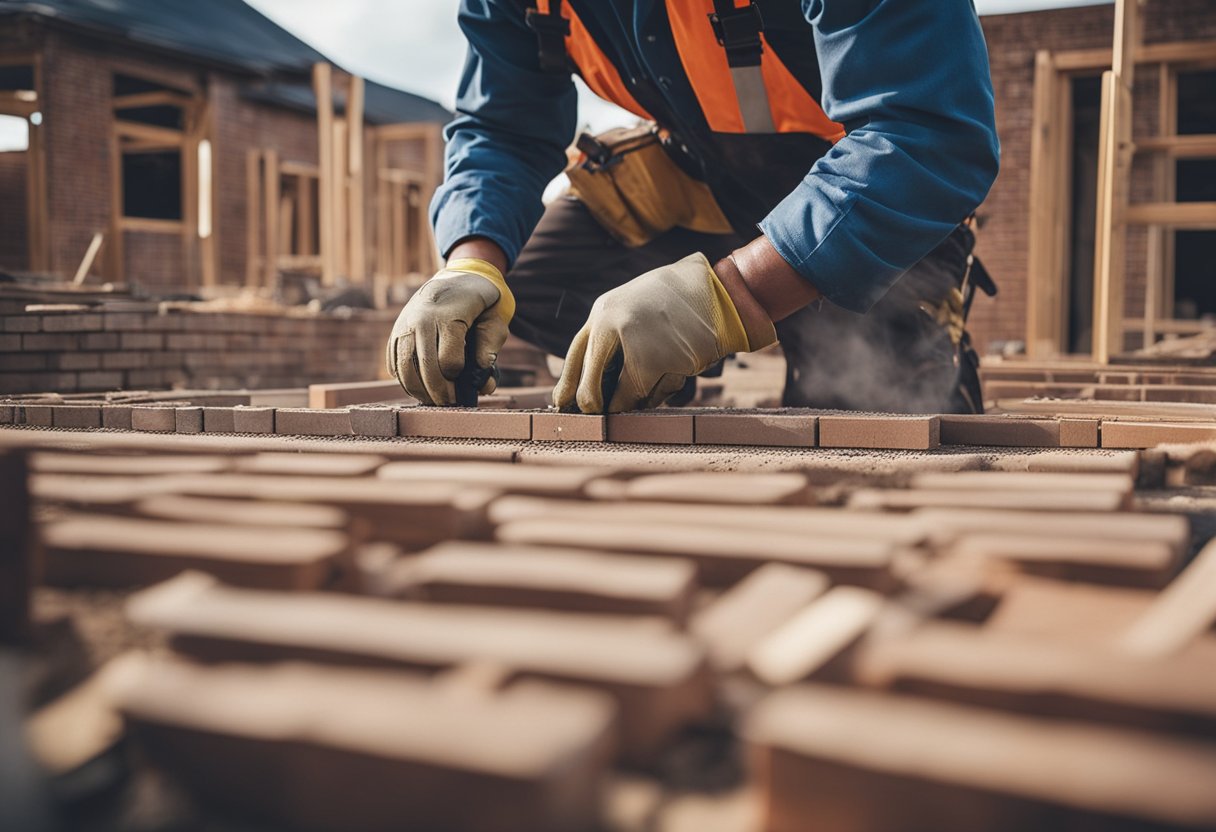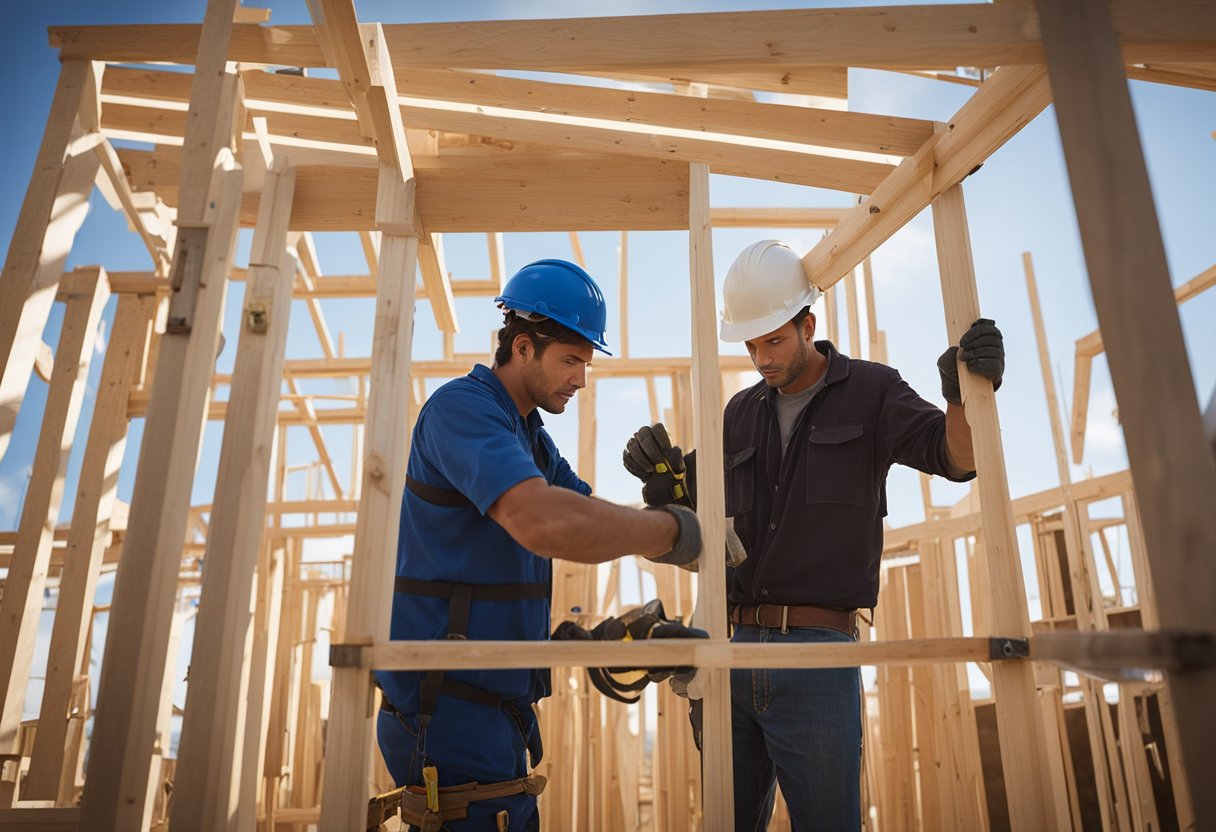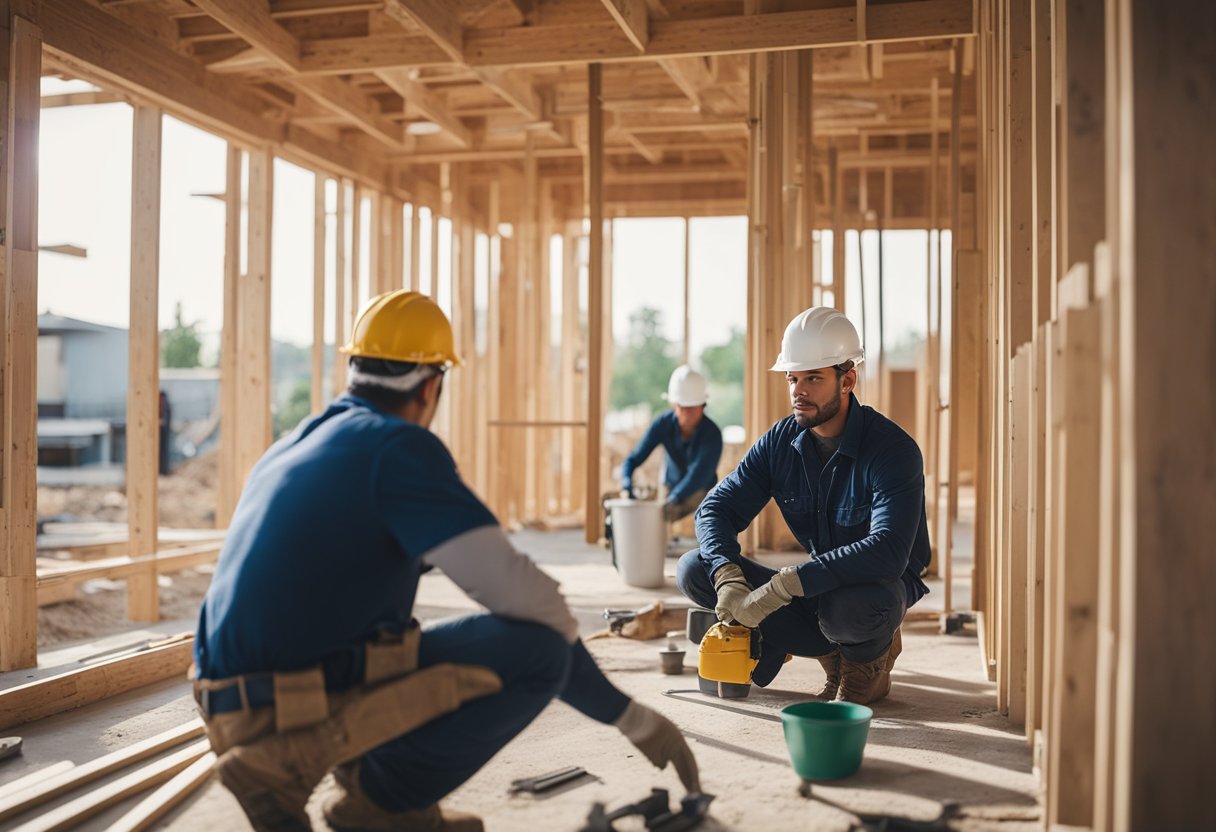Home construction is an exciting process that involves creating a new home from scratch. It can be a complex and lengthy process, but with the right knowledge and guidance, it can also be a rewarding experience. Home construction involves several stages, from planning and permits to foundation and framing, exterior and interior work, systems, and finalization.

For new home buyers in Eastern Ontario, including Belleville, Foxboro, Madoc, and Quinte West, understanding the home construction process is essential. It helps them to know what to expect and plan accordingly. The process can take several months or even years, depending on the complexity of the project. It involves working with a builder to create a custom home that meets the buyer’s specific needs and preferences.
Key Takeaways:
- Home construction involves several stages, including planning and permits, foundation and framing, exterior and interior work, systems, and finalization.
- The process can be complex and lengthy, but with the right knowledge and guidance, it can be a rewarding experience.
- Understanding the home construction process is essential for new home buyers in Eastern Ontario, from Belleville to Kingston.
Planning and Permits
When it comes to home construction, planning and securing permits are crucial steps that must be taken before any work can begin. This section will cover the key aspects of planning and permits, including choosing a builder, design and blueprints, and securing permits.
Choosing a Builder
One of the most important decisions in the planning process is choosing a builder. It is essential to select a builder with a good reputation and experience in the construction industry. Researching builders and reading reviews from previous clients can provide valuable insight into their work.
Design and Blueprints
Design and blueprints are also crucial components of the planning process. A well-designed home can maximize space and functionality while also meeting the needs of the homeowner. It is essential to work with an architect or designer to create a detailed site plan that includes property boundaries and other necessary details.
Securing Permits
Securing permits is a critical step in the planning process. A building permit is required before any construction can begin, and it is important to ensure that all necessary permits are obtained. Home construction regulatory authorities in Belleville, Foxboro, Madoc, and Quinte West (all towns in Eastern Ontario) are responsible for issuing building permits and enforcing building codes, whether it be the city or the county (Renfrew, Hastings, Prince Edward County etc etc).
In summary, planning and permits are essential components of home construction. Choosing a reputable builder, working with an architect or designer to create a detailed site plan, and securing all necessary permits are crucial steps that must be taken to ensure a smooth and successful construction process.
Foundation and Framing
Laying the Foundation
When it comes to home construction, laying the foundation is one of the most important steps. The foundation is what provides the support for the entire structure, so it’s essential that it’s done right. In Eastern Ontario, towns like Belleville, Foxboro, Madoc, and Quinte West have varying soil types and weather conditions that can affect the foundation’s design and construction.
The foundation typically starts with footings, which are wide trenches filled with concrete. The footings provide a solid base for the foundation walls to rest on. Wooden forms, concrete blocks, or poured concrete can be used to create the foundation walls. The type of material used will depend on the soil type and the design of the home. The foundation walls are then topped with a basement floor or a concrete slab.
Before the foundation walls are constructed, the builder must ensure that the site is properly excavated and graded. This will help prevent water from penetrating the foundation and causing damage. The builder must also obtain the necessary permits and inspections, including a framing inspection, to ensure that the foundation is built to code.
Erecting the Frame
Once the foundation is complete, the next step is to erect the frame. In Eastern Ontario, wooden framing is the most common type of construction. The frame consists of vertical studs, horizontal plates, and beams that support the weight of the roof and walls.
The frame is typically constructed on the foundation, starting with the floor. The floor is anchored to the foundation, and then covered with a subfloor. From there, the builder can begin framing the walls and roof. The framing is inspected to ensure that it’s done correctly and meets building codes.
In conclusion, laying the foundation and erecting the frame are critical steps in building a home. It’s essential to use the right materials and techniques to ensure that the foundation is strong and stable, and the frame can support the weight of the structure. By obtaining the necessary permits and inspections, builders can ensure that their work meets local building codes and regulations.
Exterior and Interior Work

When it comes to home construction, exterior and interior work are two important aspects that require careful attention. This section will cover the different components of exterior and interior work, including roofing and siding, doors and windows, and interior finishes.
Roofing and Siding
The roofing and siding of a home are crucial components that protect it from the elements. In South-Eastern Ontario, we experience harsh weather conditions, making it important to choose durable materials for roofing and siding. Homeowners can choose from a variety of materials such as asphalt shingles, metal roofing, vinyl siding or wood siding.
Each material has its own pros and cons, and it is important to choose the one that best suits the homeowner’s needs and budget.
Doors and Windows
Doors and windows are not only functional components of a home, but they also add to its aesthetic appeal. In Eastern Ontario, towns like Belleville, Foxboro, Madoc, and Quinte West experience different seasons, making it important to choose doors and windows that are energy-efficient and can withstand extreme weather conditions. Homeowners can choose from different types of doors and windows such as sliding, casement, or double-hung windows, and steel or fiberglass doors.
Interior Finishes
Interior finishes include insulation, drywall, painting, trim, interior doors, flooring, cabinets, and fixtures. These components add the finishing touches to a home and make it livable. Homeowners can choose from different types of insulation such as fiberglass, cellulose, or spray foam, and different types of flooring such as hardwood, laminate, or tile. Cabinets and fixtures come in different styles and finishes, and it is important to choose ones that match the overall design and theme of the home.
Exterior and interior work are important aspects of home construction that require careful consideration. Homeowners should choose materials and components that are durable, energy-efficient, and can withstand harsh weather conditions.
Systems and Finalization

Once the construction of a home is complete, the systems of the house must be installed and finalized before the final inspection and walk-through. This section covers the installation and finalization of plumbing, electrical, heating, ventilation, and cooling systems.
Plumbing and Electrical
The plumbing and electrical systems are crucial to the functionality of a home. These systems must be installed by licensed professionals and must meet the standards set by the municipal and building inspections. The installation of plumbing and electrical systems involves the following steps:
- Rough-in: This is the initial installation of pipes and wires before the walls are closed up.
- Inspection: After the rough-in, the plumbing and electrical systems are inspected to ensure they meet the building code requirements.
- Final installation: Once the inspections are passed, the final installation of fixtures and outlets can be completed.
Heating and Cooling
The heating, ventilation, and cooling (HVAC) system is responsible for maintaining a comfortable temperature inside the home. The installation of the HVAC system involves the following steps:
- Ductwork: The ductwork is installed before the walls are closed up.
- HVAC installation: Once the ductwork is in place, the HVAC system can be installed.
- Inspection: The HVAC system is inspected to ensure it meets the building code requirements.
Final Inspection and Walk-Through
Before the final inspection and walk-through, all systems must be installed and finalized. The final inspection and walk-through involve the following steps:
- Municipal inspections: The municipal inspections must be completed before the building inspector can perform the final inspection.
- Building inspections: The building inspector will perform a final inspection to ensure the home meets the building code requirements.
- Final walk-through: The final walk-through is conducted with the homeowner to ensure that all systems are functioning properly and that there are no issues.
Overall, the installation and finalization of plumbing, electrical, heating, ventilation, and cooling systems are crucial to the functionality and comfort of a home. It is important to hire licensed professionals to ensure that the systems meet the standards set by the municipal and building inspections. In Eastern Ontario, towns such as Belleville, Foxboro, Madoc, and Quinte West have licensed professionals who can assist in the installation and finalization of these systems.
Frequently Asked Questions
What are the necessary steps for building a house in Canada?
Building a house in Canada involves several necessary steps. Firstly, one must acquire a building permit from the local municipality or town. The permit is granted upon submission of the building plans and payment of the required fees. Secondly, the builder must ensure that the construction adheres to the building codes and standards set by the government. Lastly, the builder must obtain a final inspection from the relevant authorities before occupancy.
What is the New Home Construction Licensing Act, 2017, and how does it impact builders in Ontario?
The New Home Construction Licensing Act, 2017, is a law that regulates the construction of new homes in Ontario. The act requires that all builders and vendors of new homes be licensed by the Home Construction Regulatory Authority (HCRA) before they can sell or build new homes. The act aims to protect consumers from unscrupulous builders and ensure that only qualified builders construct new homes in Ontario.
What are the typical phases involved in the construction of a new home?
The construction of a new home involves several phases. Firstly, the builder must prepare the site for construction, including clearing the land and installing the foundation. Secondly, the builder constructs the frame and installs the roof, windows, and doors. Thirdly, the builder installs the electrical, plumbing, and HVAC systems. Lastly, the builder finishes the interior and exterior of the home, including painting, flooring, and landscaping.
How does Tarion warranty protection work for new homes in Ontario?
Tarion warranty protection is a warranty that covers new homes in Ontario. The warranty protects homeowners against defects in workmanship and materials for up to seven years after the home is constructed. The warranty also covers deposit protection and delayed closing compensation. Tarion is responsible for administering the warranty and resolving disputes between homeowners and builders.
What You Really Want
Find yourself a builder in the Belleville area of Eastern Ontario that will listen to your needs, your budget, and your concerns, and develop a perfect plan for building your new home.
- Harmony Homes
- 8125 ON-62, Foxboro, ON K0K 2B0
- (613) 961-1717
- https://harmonyhomes.builders/